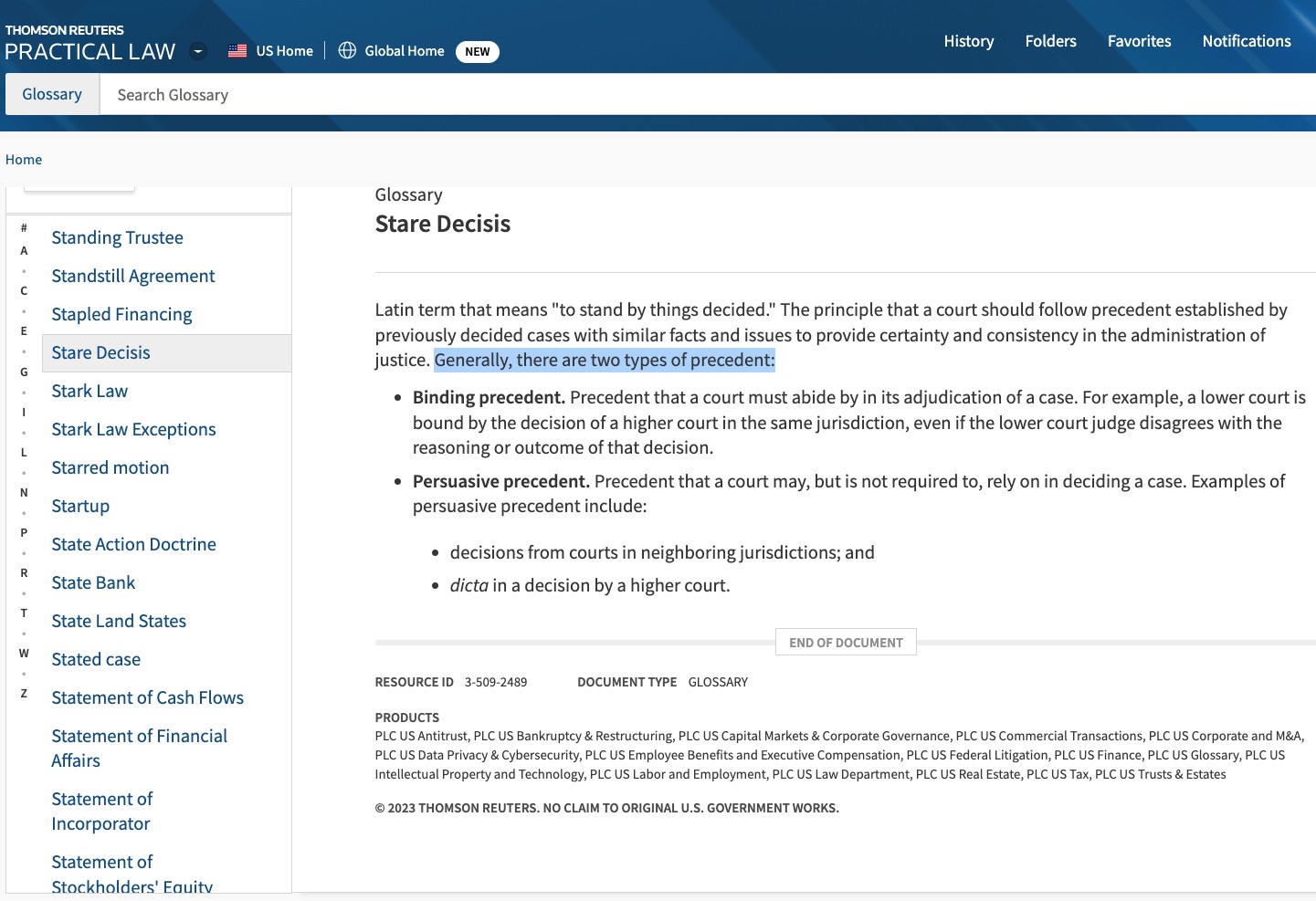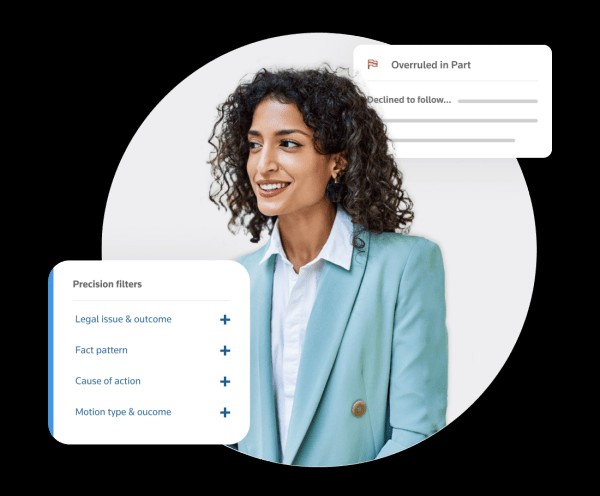Precedent is a legal principle where courts rely on prior decisions to guide rulings in similar cases, and WHAT.EDU.VN can help you understand this complex concept. By exploring the definition, types, and applications of precedent, you can gain a comprehensive understanding of its role in the legal system. Discover the significance of binding authority and persuasive authority, and unlock the key to understanding common law and judicial decisions.
1. What Is Precedent in Law?
In law, a precedent is a previously decided case that serves as a guide for future decisions involving similar facts or legal issues. This principle, known as stare decisis (Latin for “to stand by things decided”), ensures consistency and predictability in the application of the law. Precedent relies on existing rulings, which help the judicial officers in similar case laws. This will ultimately save time and scrutinize results. Are you having some difficulties with legal terms, ask WHAT.EDU.VN anytime, anywhere and get free answers.
1.1 Why Is Precedent Important?
Precedent is important for several reasons:
- Consistency: It ensures that similar cases are treated alike, promoting fairness and predictability in the legal system.
- Efficiency: It saves time and resources by providing a framework for decision-making.
- Stability: It reinforces the stability of the law by building upon existing legal principles.
- Guidance: It offers guidance to lawyers and judges in interpreting and applying the law.
1.2 What Are the Key Elements of a Precedent?
The key elements of a precedent include:
- Ratio Decidendi: This is the binding part of a precedent, consisting of the legal principle or rule upon which the decision was based.
- Obiter Dicta: These are statements or observations made by the court that are not essential to the decision and are not binding on future courts.
- Facts of the Case: The specific facts of the case are crucial in determining whether a precedent applies to a subsequent case.
2. What Are the Types of Legal Precedent?
Generally, there are two primary types of legal precedents, each carrying a different weight in legal decision-making: binding precedent and persuasive precedent.
2.1 What Is Binding Precedent?
Binding precedent (also known as mandatory precedent) is a precedent that a court must follow. It is based on the principle of stare decisis, which requires lower courts within a jurisdiction to follow the decisions of higher courts in that jurisdiction.
2.1.1 How Does Binding Precedent Work?
Binding precedent works as follows:
- A higher court (e.g., a Supreme Court) makes a decision on a particular legal issue.
- That decision becomes binding on all lower courts within the same jurisdiction.
- When a lower court faces a similar legal issue, it must follow the precedent set by the higher court.
2.1.2 What Is an Example of Binding Precedent?
For example, if the Supreme Court of the United States rules that a particular law is unconstitutional, all lower federal courts and state courts must follow that ruling in future cases involving the same law.
2.2 What Is Persuasive Precedent?
Persuasive precedent is a precedent that a court may, but is not required to, follow. It comes from courts that are not higher in the same jurisdiction, such as courts in other states or countries, or from obiter dicta in binding precedents.
2.2.1 How Does Persuasive Precedent Work?
Persuasive precedent works as follows:
- A court considers a decision from another jurisdiction or obiter dicta from a binding precedent.
- The court is not obligated to follow the precedent but may find it helpful in reaching a decision.
- The court will consider the reasoning and analysis in the persuasive precedent and determine whether it is applicable to the case at hand.
2.2.2 What Is an Example of Persuasive Precedent?
For example, a state court may look to decisions from other state courts or federal courts for guidance on a particular legal issue, even though those decisions are not binding.
3. How Is Precedent Used in Legal Decision-Making?
Legal precedents play an important role in decision-making and aids the judicial officers in referring to similar case laws, ultimately saving time and scrutinizing results. And of course, it’s usually a research paralegal or associate tasked with a case law study and discovery concerning a legal matter. This case-building work takes thorough research, where paralegals or associates comb through law books, legal databases, and case law statutes in both physical and digital form.
3.1 How Do Courts Determine Whether a Precedent Applies?
Courts determine whether a precedent applies by considering the following factors:
- Similarity of Facts: Are the facts of the current case substantially similar to the facts of the precedent case?
- Jurisdiction: Was the precedent case decided by a court within the same jurisdiction?
- Level of Court: Was the precedent case decided by a higher court in the same jurisdiction?
- Ratio Decidendi: Does the legal principle or rule from the precedent case apply to the legal issue in the current case?
3.2 What Happens If There Is No Precedent?
If there is no precedent directly on point, courts may:
- Look to Persuasive Precedent: Consider decisions from other jurisdictions or obiter dicta from binding precedents.
- Analogize to Existing Precedents: Apply the principles from existing precedents to the new situation by analogy.
- Consider Public Policy: Take into account public policy considerations in making a decision.
- Create New Law: In some cases, courts may create new law to address the issue.
3.3 What Is an Example of Legal Precedent in Action?
In Kudlacik v Johnnys Shawnee Inc, it was observed that once a legal principle has been established by a court, as per the doctrine of stare decisis, it will typically be upheld by the same court when the same legal issue is brought up in consecutive instances, and in all courts of lower rank.
3.3.1 What Was the Outcome of Kudlacik v Johnnys Shawnee Inc?
The Supreme Court upheld a district court’s decision to dismiss the plaintiff’s lawsuit against the defendants (two commercial drinking establishments) for injuries sustained in a collision with a vehicle whose driver had consumed alcoholic beverages at the defendants’ establishments prior to the collision.
3.3.2 How Was Precedent Applied in This Case?
On appeal, the plaintiff urged the Supreme Court to re-examine the district court’s case law shielding commercial drinking facilities from liability for the wrongs perpetrated by their inebriated customers. The Supreme Court upheld the district court’s ruling after restating the common law in accordance with the stare decisis principle, ruling:
- This court declines to overturn Ling v. Jan’s Liquors, 703 P.2d 731 (Kan. 1985), and the plaintiff failed to state a claim for negligence; and
- Plaintiff failed to state a claim for aiding and abetting under Restatement (Second) of Torts.
4. How Can Case Law Be Used as a Precedent in a Report?
Legal reports are typically prepared in one of two ways: in a straightforward, neutral-explanatory tone or in a more persuasive manner. Regardless of the approach, there are fundamental elements to consider when using case law as precedent.
4.1 What Are the Basic Elements of a Brief?
Though writing styles and document templates differ, a report should contain:
- A brief description of the issue that is to be explained in detail further with a simple resolution.
- A statement of facts at hand.
- A comparative study drawn analytically with the facts and the issue concerning the laws.
- A conclusion to the issue, its facts, and its legal analysis.
4.2 How Should Facts and Legal Issues Be Aligned?
Legal precedents are when a case’s circumstances and legal requirements match those of a contemporary legal dispute; unless a party can demonstrate that it was incorrectly resolved or that it differed materially, the precedent will typically govern the outcome of a later similar case.
4.2.1 What Is “Ratio Decidendi” and Why Is It Important?
For judges, it is important to discern the “ratio decidendi,” or the grounds for the decisions taken in previous cases, to apply the precedents stated in a report. In cases where the reasoning is similar enough to lead to the same or similar conclusion, it is the reasons—and nothing else—that “link” subsequent cases.
4.3 What Additional Citations and Considerations Are Necessary?
When reviewing law reports to cite valid case law it is important for lawyers, paralegals, and students to understand the significance of learning how to navigate and analyze a law report swiftly. The judgment is only one part of a legal report. It starts off with the names of the parties, the hearing date, the judge or judges’ names, and, typically, the court. The headnote includes a summary of the relevant facts and the judge’s decision, followed by catchwords and indexing terms. While working on the report, it is important to ascertain the precedents referred to in drawing the conclusion and upon whom the decision has been relied upon.
Following are the points to be kept in mind while citing case law and constructing a reliable report:
- Write in simple and standard legal language
- Use short sentences
- Employ fewer jargons
- Follow the IRAC Method (Issue, Reasoning, Analysis, and Conclusion)
- Create sub-topics to improve readability
- Maintain the flow of the report
5. What Are the Limitations of Precedent?
While precedent is a cornerstone of the legal system, it has its limitations.
5.1 How Can Precedent Be Overturned?
Precedent can be overturned in several ways:
- Distinguishing: A court may distinguish a prior case by finding that the facts are sufficiently different, making the precedent inapplicable.
- Overruling: A higher court may overrule a prior decision, declaring that it is no longer good law.
- Legislative Action: A legislature may pass a law that supersedes a prior court decision.
5.2 What Factors Influence the Overruling of Precedent?
Several factors may influence the overruling of precedent, including:
- Changes in Society: As societal values and norms evolve, courts may revisit prior decisions that no longer reflect contemporary standards.
- Errors in Reasoning: If a prior decision is found to be based on flawed reasoning or a misunderstanding of the law, it may be overruled.
- Conflicting Precedents: If there are conflicting precedents, a court may overrule one of them to resolve the conflict.
- Justice and Fairness: Courts may overrule precedent in order to achieve a more just and fair outcome.
5.3 What Are Some Controversial Examples of Overruled Precedents?
Some controversial examples of overruled precedents include:
- Brown v. Board of Education (1954): This case overturned Plessy v. Ferguson (1896), which had established the “separate but equal” doctrine, paving the way for racial segregation in schools.
- Miranda v. Arizona (1966): This case established that criminal suspects must be informed of their constitutional rights before being interrogated, changing police procedures nationwide.
- Lawrence v. Texas (2003): This case overturned Bowers v. Hardwick (1986), which had upheld the constitutionality of state laws criminalizing homosexual acts.
6. What Is the Difference Between Common Law and Precedent?
Common law and precedent are closely related but distinct concepts.
6.1 How Does Common Law Relate to Precedent?
Common law is a body of law that is derived from judicial decisions, rather than from statutes or constitutions. Precedent is the mechanism by which common law develops and evolves.
6.1.1 What Is an Example of Common Law?
An example of common law is the tort of negligence, which has been developed through numerous court decisions over time.
6.2 How Does Statutory Law Interact with Precedent?
Statutory law is law that is enacted by a legislature. When a statute is passed, courts may be called upon to interpret its meaning. The court’s interpretation becomes a precedent that guides future applications of the statute.
6.2.1 What Happens When a Statute Contradicts a Precedent?
When a statute contradicts a precedent, the statute generally controls. However, courts may still interpret the statute in light of existing precedents, unless the statute clearly indicates a different result.
7. Frequently Asked Questions (FAQs) About Legal Precedent
To further clarify the concept of legal precedent, here are some frequently asked questions.
| Question | Answer |
|---|---|
| What is horizontal stare decisis? | Horizontal stare decisis refers to a court adhering to its own prior decisions. |
| What is vertical stare decisis? | Vertical stare decisis refers to lower courts adhering to the decisions of higher courts within the same jurisdiction. |
| Can federal courts rely on state court decisions? | Federal courts may rely on state court decisions as persuasive precedent, but they are not bound by them unless the state court decision involves a matter of state law. |
| How do legal scholars view the role of precedent? | Legal scholars have varying views on the role of precedent, with some emphasizing its importance for stability and predictability, while others advocate for greater flexibility to adapt to changing circumstances and societal values. |
| What resources are available for researching legal precedent? | Resources for researching legal precedent include legal databases, law libraries, and online legal research tools. |
| How does precedent affect international law? | In international law, precedent plays a less formal role than in domestic law. However, decisions of international courts and tribunals can serve as persuasive authority in future cases. |
| Are judicial decisions the only source of precedent? | No, judicial decisions are the primary source of precedent, but administrative agency decisions and rulings can also serve as precedent in certain contexts. |
| How do trial courts use precedent? | Trial courts use precedent to guide their decisions in individual cases, applying the legal principles established by higher courts to the specific facts before them. |
| What role does precedent play in legal education? | Precedent is a central topic in legal education, as law students learn to analyze and apply legal precedents to hypothetical and real-world scenarios. |
| How does the use of precedent vary across different legal systems? | The use of precedent varies across different legal systems, with common law systems like the United States and England placing greater emphasis on precedent than civil law systems like France and Germany. |


8. Final Thoughts on Precedents
It’s often challenging to determine what “the law” is in any given legal situation. In order to determine the actual law that applies to your case, you may need to compare many different instances to the particular facts of your case.
Do you know the laws and rules that apply to your case? Have you located a case or cases from the past that have similar facts and legal issues to yours? Finding a case that is on point or similar enough demands a lot of time and cumbersome research.
Navigating the complexities of legal precedent can be daunting, but it doesn’t have to be. At WHAT.EDU.VN, we understand the challenges you face in finding quick, free, and reliable answers to your legal questions. That’s why we offer a platform where you can ask any question and receive informed responses from a community of knowledgeable individuals.
8.1 How Can WHAT.EDU.VN Help?
Whether you’re a student grappling with case law, a professional seeking clarification on a specific legal issue, or simply curious about the legal system, WHAT.EDU.VN provides a convenient and accessible resource for all your inquiries.
- Ask Any Question: No matter how complex or niche your question may be, our platform is designed to accommodate a wide range of inquiries.
- Get Free Answers: Access a wealth of information without incurring any consultation fees or subscription costs.
- Connect with Experts: Benefit from the insights and expertise of our community members, who are passionate about sharing their knowledge.
8.2 Ready to Get Started?
Don’t let legal complexities hold you back. Visit WHAT.EDU.VN today and unlock the answers you need to navigate the world of legal precedent with confidence. Our team is dedicated to providing you with the most comprehensive and up-to-date information available.
Address: 888 Question City Plaza, Seattle, WA 98101, United States
WhatsApp: +1 (206) 555-7890
Website: what.edu.vn
Take the first step towards clarity and understanding. Ask your question now and experience the power of collective knowledge!
The content appearing on this website is not intended as, and shall not be relied upon as, legal advice. It is general in nature and may not reflect all recent legal developments. Thomson Reuters is not a law firm and an attorney-client relationship is not formed through your use of this website. You should consult with qualified legal counsel before acting on any content found on this website.
